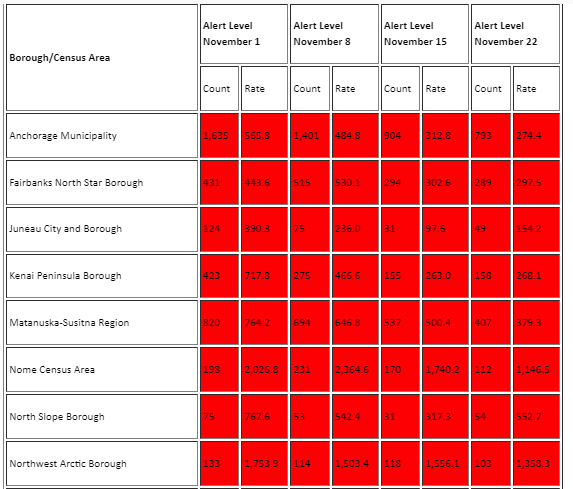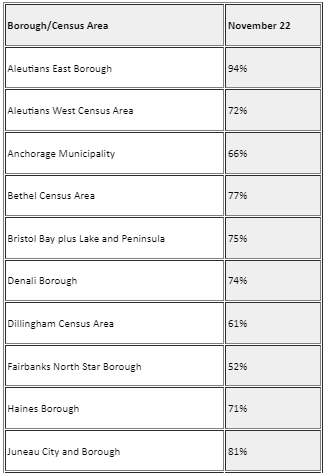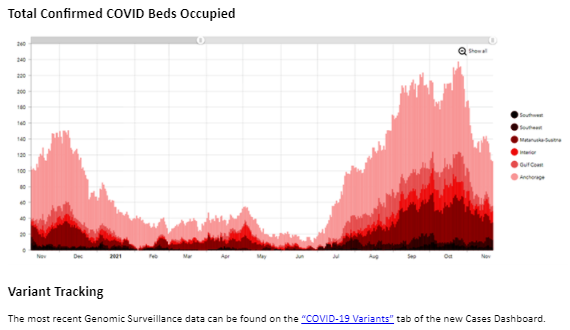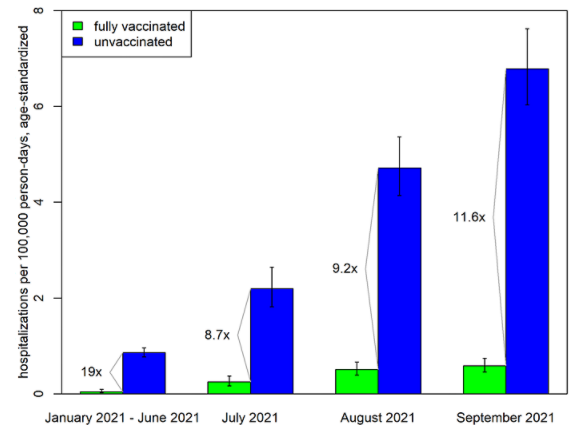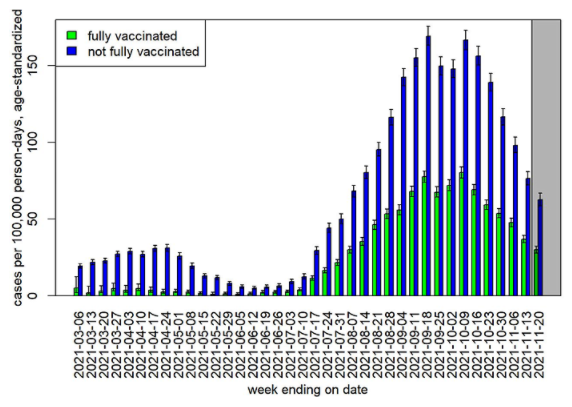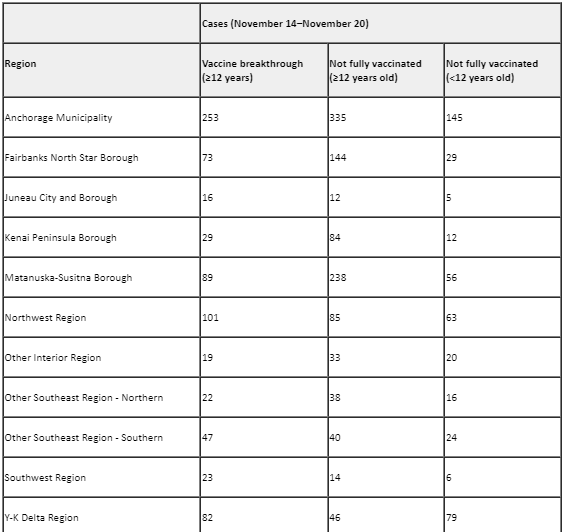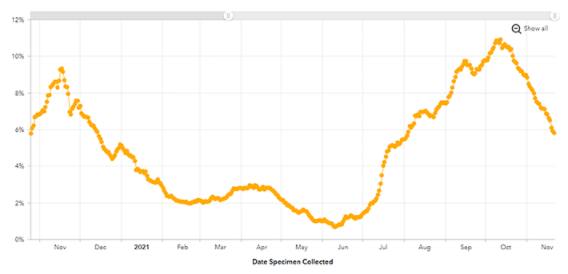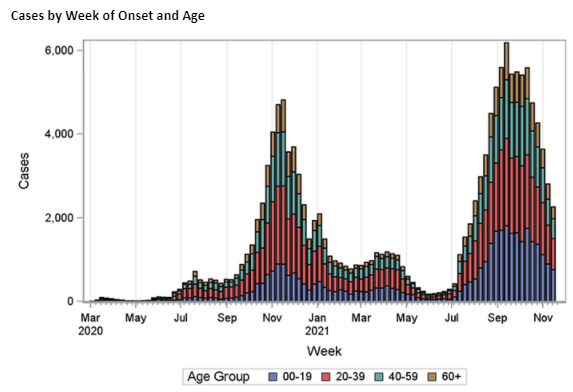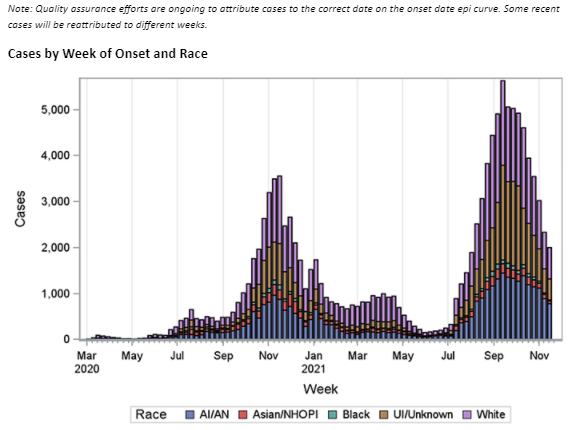Are you looking for a shipping solution? Maybe you need to change freight carriers? Find out what the hard working and reliable people at Team Worldwide can do over land, sea and air
Alaska Department of Health & Social Services Weekly Case Update
November 14 — November 20, 2021
Case Trends
- Alaska currently has the eighteenth highest number of cases in the last seven days per 100,000 population among the 50 states.
- Hospital capacity has been strained during the Delta variant wave of COVID-19 such that in some hospitals, it may become difficult to care for everyone who needs care, even for non-COVID health concerns. Some care may need to be delayed, there may be long wait times, and hospital beds may not be available.
- Hospitalizations are continuing to occur in younger Alaskans, with the median age of persons hospitalized due to COVID-19 in 2021 being about 5 years younger than in 2020.
- Among those hospitalized due to COVID-19 and with specimen collection dates from January 16, 2021 through November 20, 2021, unvaccinated and partially vaccinated patients had a median age 14 years younger than fully vaccinated patients.
- Very high levels of COVID-19 transmission are occurring throughout much of Alaska.
- 2,705 cases were reported in Alaskans the week of November 14–November 20. This is a 3.6% decrease from the number of cases reported the week before and indicates a downward trajectory. The course of the COVID-19 pandemic is difficult to predict, and the pattern of declining cases may not be sustained in future weeks.
- In the five largest boroughs (Anchorage Municipality, Matanuska-Susitna Borough, Fairbanks North Star Borough, Kenai Peninsula Borough, and City and Borough of Juneau), the number of new COVID-19 cases each week appears to be declining.
- Regardless of the trajectories, high levels of community transmission are widespread and causing significant illness, death, and demand on the health care system.
- The 7-day test positivity rate in Alaska has declined since mid-October, but it remains elevated, and testing continues to be important.
- The intensity of COVID-19 transmission varies substantially between communities outside the largest boroughs. COVID-19 cases are regularly reported from nearly all boroughs and census areas and some communities are experiencing extremely widespread transmission.
- Please get vaccinated if you haven’t already and get a booster dose if you are eligible (see below for more information). Currently available COVID vaccines will help protect you, your family, and your community against COVID-19, including the Delta variant.
- Wearing a mask when in indoor public spaces regardless of vaccination status is an important step to take to slow the spread of COVID-19. Most Alaskans live in an area with substantial or high community transmission where this action is needed to protect your health and the health of others.
- Continue to avoid crowds and practice social distancing – particularly when indoors.
- Seek testing if you have any symptoms or have been exposed to an infected person. If you do test positive, isolate right away, and notify your contacts. Ask them to get tested and, if they are unvaccinated, to quarantine.
- If you test positive and you’re at increased risk for severe COVID, obtain monoclonal antibody treatment. This has been shown to be an effective treatment for reducing the risk of hospitalization. This treatment works best when given early.
- Persons at high risk include but are not limited to persons who are elderly, immunocompromised, obese, pregnant, or have certain chronic underlying medical conditions.
- Alert levels are based on the case counts over the past 7 days as well as the daily number of reported cases over the past 7 days per 100,000 population.
- Alert levels have been changed to more closely mirror CDC’s community transmission indicator and are calculated by borough and census area, rather than by region.
*Rates based on <20 observations are statistically unreliable and should be used with caution.
**Rates based on <6 observations are not reported.
Vaccination Status
**Rates based on <6 observations are not reported.
Vaccination Status
- Anyone aged ≥5 years in Alaska is now eligible to receive a COVID-19 vaccine.
- If you have received an initial dose of the Pfizer or Moderna COVID-19 vaccine, be sure to get your second dose too. Scientific studies have shown that two doses of an mRNA vaccine are more effective than one dose of an mRNA vaccine, especially against emerging variants of concern.
- Everyone ≥18 years old who received the primary series of an mRNA (Pfizer or Moderna) COVID-19 vaccine ≥6 months ago is now eligible for a booster dose.
- In particular, persons aged ≥50 years and persons aged 18+ who live in long-term care settings should receive a booster dose.
- For people who received the Janssen (Johnson & Johnson) COVID-19 vaccine, a booster dose (either the Janssen vaccine again or an mRNA vaccine) is recommended for anyone aged ≥18 years who was vaccinated ≥2 months ago.
- Learn more about who should get a booster dose and to find COVID-19 vaccines near you at covidvax.alaska.gov.
- CDC recommends that people with moderately to severely compromised immune systems receive an additional dose of mRNA COVID-19 vaccine at least 28 days after a second dose of an mRNA vaccine.
- Vaccinated persons with immunocompromising conditions should discuss with their health care providers the need for additional personal protective measures.
- To schedule your vaccine appointment visit covidvax.alaska.gov or call 907-646-3322.
- To find clinics in your area you can visit vaccines.gov or text your zip code to GETVAX (438829) in English, or VACUNA (822862) for Spanish.
- The Alaska vaccine dashboard is available online for the most up-to-date data.
New Hospitalizations and Deaths
- Cumulative hospitalizations increased by 98 to 3,001. Hospitalization reports often lag when a case was initially reported.
- 11% of hospitalized patients in Alaska had COVID-19 as of November 23, 2021.
- On November 20th there were 103 persons with COVID-19 in AK hospitals, which is a 23.7% decrease relative to the week before when there were 135 persons hospitalized.
- The cumulative number of COVID-19 deaths among Alaska residents increased by 29 to 832. It is common to take some time for a death to be reported and verified, and deaths that occurred during November 14–November 20 may be reported in the future after death certificates are reviewed.
Vaccine Breakthrough Cases
- Vaccine breakthrough (VB) infections of COVID-19 are those detected in a person who is at least 2 weeks beyond their second dose of a 2-dose series or the only dose of a 1-dose series.
- Alaska residents who are fully vaccinated are much less likely to be hospitalized due to COVID-19 than those who are not fully vaccinated. (Age-standardized per capita rates of COVID-19 hospitalizations by vaccination status are updated monthly.)
- The following updated VB data are among Alaska residents aged ≥12 years with a specimen collection date from January 16–November 20, 2021. (Children ages 5 to 11 are not included because at this time they have not been eligible for vaccination long enough to become fully vaccinated.)
- From January 16–November 20, 2021, 99 deaths, 288 hospitalizations, and 23,020 cases with a VB infection were reported among Alaska residents aged ≥12 years. These counts are provisional and subject to change as data are compiled and reviewed. In that same time frame, a total of 76,775 cases, 1,814 hospitalizations, and 524 deaths were reported.
- 70% of all cases, 84% of all hospitalizations, and 81% of deaths among Alaska residents aged ≥12 years from January 16–November 20, 2021 were in people who were not fully vaccinated.
- More detailed information about hospitalizations, deaths, and vaccine breakthrough infections and reinfections among Alaska residents can also be found in the monthly report, which has been updated to include data through September.
- Age-standardized per capita rates of COVID-19 cases by vaccination status are updated weekly. Some COVID-19 cases with specimen collection in the immediate past week (indicated by the grey box) may have not yet been reported or counted.
The following table shows by region the number of vaccine breakthrough cases, the number of cases among persons aged ≥12 years who are not fully vaccinated, and the number of cases among children 11 years and younger who are not fully vaccinated. (Children 5 to 11 years old have not been eligible for vaccination long enough to be considered fully vaccinated).
- A variety of factors may affect the proportion of vaccine breakthrough cases by region. In communities with higher vaccination coverage, a larger proportion of cases is expected to occur among fully vaccinated persons. Other potential factors include the extent of prior infection in a region and differences in testing practices between regions.
- DHSS Insights Blog: Celebrate the Holidays Safely
- New video PSAs to share:
- Pediatric COVID-19 Vaccine Flyer: 5 Reasons to Vaccinate for Ages 5+
- COVID-19 Vaccine Booster Chart: Boosters are now authorized for all COVID-19 vaccines for anyone 18+ with mixed dosing allowed
- New Over-the-Counter Testing Flyer: At-home COVID-19 tests
- New Flyer for Schools regarding ordering Over-the-Counter Testing Kits: Over-the-Counter COVID-19 Antigen Tests for Schools
- Revised COVID-19 Webpages: COVID-19 Prevention | COVID-19 Testing | Find Your COVID-19 Vaccine
- New social media posts to share: Celebrate the Holidays Safely | Safe Travels Home for the Holidays | Fight the Flu
- DHSS offers free presentations upon request to groups about COVID-19, the vaccines, COVID-19 prevention, or other health topics upon request. Learn more or request a presentation on our Speaker’s Bureau web page.
- DHSS offers support for one-time or reoccurring COVID-19 vaccination events. Submit your request for support and provide information about the event by filling out this form.
- Can’t tune into a live ECHO videoconference but don’t want to miss out on the latest updates? The full schedule of ECHO sessions and access to COVID-19 ECHO videos and slideshows are available for download anytime on the DHSS ECHO web page.
(Seven day rolling average)
Note: Quality assurance efforts are ongoing to attribute cases to the correct date on the onset date epi curve. Some recent cases will be reattributed to different weeks. Race abbreviations include AI/AN (American Indian or Alaska Native), Asian/NHOPI (Asian, Native Hawaiian or Other Pacific Islander), and UI/Unknown (Under investigation or unknown).
Additional informational resources:
The next Local Government ECHO will be December 15th.
Additional informational resources:
- The State of Alaska COVID-19 vaccine status update page
- The State of Alaska COVID-19 information page provides more information about the virus and how individuals and businesses can protect themselves and others from transmission.
- For the most up-to-date case information, see the Alaska Coronavirus Response Hub dashboard: data.coronavirus.alaska.gov. All dashboard data are updated Monday through Friday.
- For DHSS media inquiries, please contact [email protected]
The next Local Government ECHO will be December 15th.



